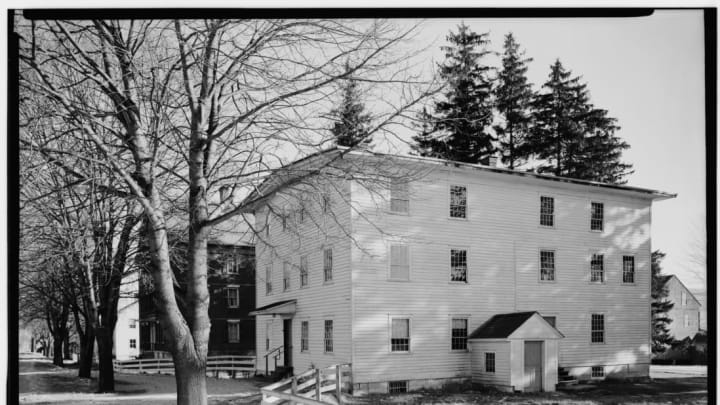4 Utopian Communities That Didn't Pan Out
By Floss books

Every once in a while, a proud little community will sprout up just to let the world know how Utopia should be run. With chins raised almost as high as ideals, the community marches forth to be an example of perfection. But in most cases, all that harmonious marching gets tripped up pretty quickly. Here are four "perfect" communities that whizzed and sputtered thanks to human nature.
1. Brook Farm (or, Ripley's Follow Me or Not)
Perhaps the best-known utopian community in America, Brook Farm was founded in 1841 in West Roxbury, Massachusetts, by George and Sophia Ripley. The commune was built on a 200-acre farm with four buildings and centered on the ideals of radical social reform and self-reliance. For free tuition in the community school and one year's worth of room and board, the residents were asked to complete 300 days of labor by either farming, working in the manufacturing shops, performing domestic chores or grounds maintenance, or planning the community's recreation projects. The community prospered in 1842-1843 and was visited by numerous dignitaries and utopian writers.
However, Ripley joined the unpopular Fourierism movement, which meant that soon the young people (out of a "sense of honor") had to do all the dirty work like repairing roads, cleaning stables, and slaughtering the animals. This caused many residents, especially the younger ones, to leave. Things went downhill from there. The community was hit by an outbreak of smallpox followed by fire and finally collapsed in 1847.
2. Fruitlands: A Utopian Community (for Six Months Anyway)
After visiting Brook Farm and finding it almost too worldly by their standards, Bronson Alcott (the father of Louisa May) and Charles Lane founded the Fruitlands Commune in June 1843, in Harvard, Massachusetts.
Structured around the British reformist model, the commune's members were against the ownership of property, were political anarchists, believed in free love, and were vegetarians. The group of 11 adults and a small number of children were forbidden to eat meat or use any animal products such as honey, wool, beeswax, or manure. They were also not allowed to use animals for labor and only planted produce that grew up out of the soil so as not to disturb worms and other organisms living in the soil.
Many in the group of residents saw manual labor as spiritually inhibiting and soon it became evident that the commune could not provide enough food to sustain its members. The strict diet of grains and fruits left many in the group malnourished and sick. Given this situation, many of the members left and the community collapsed in January 1844.
3. The Shakers
Officially known as the United Society of Believers in Christ's Second Appearing, the Shakers were founded in Manchester, England, in 1747. As a group of dissenting Quakers under the charismatic leadership of Mother Ann Lee, the Shakers came to America in 1774.
Like most reformist movements of the time, the Shakers were agriculturally based, and believed in common ownership of all property and the confession of sins. Unlike most of the other groups, the Shakers practiced celibacy, or the lack of procreation. Membership came via converts or by adopting children. Shaker families consisted of "brothers" and "sisters" who lived in gender-segregated communal homes of up to 100 individuals. During the required Sunday community meetings it was not uncommon for members to break into a spontaneous dance, thus giving them the Shaker label.
As pacifists they were exempted from military service and became the United States' first conscientious objectors during the Civil War. Currently, however, there isn't a whole lot of Shaking going on. As the younger members left the community, converts quit coming, and the older ones died off, many of the communities were forced to close. Of the original 19 communities, most had closed by the early 1900s.
4. Pullman's Capitalist Utopia
Located 15 miles south of Chicago, the town of Pullman was founded in the 1880s by George Pullman (of luxury railway car fame) as a utopian community based on the notion that capitalism was the best way to meet all material and spiritual needs. According to Pullman's creed, the community was built to provide Pullman's employees with a place where they could exercise proper moral values and where each resident had to adhere to the strict tenets of capitalism under the direction and leadership of Pullman. The community was run on a for-profit basis—the town had to return a profit of 7 percent annually. This was done by giving the employees two paychecks, one for rent, which was automatically turned back in to Pullman, and one for everything else. Interestingly, the utopian community had very rigid social class barriers, with the management and skilled workers living in stately homes and the unskilled laborers living in tenements. The experiment lasted longer than many of the other settlements, but ultimately failed. Pullman began demanding more and more rent to offset company losses, while union sentiment grew among the employee residents.
This article originally appeared in the Mental Floss book Forbidden Knowledge.